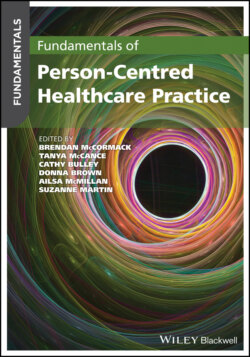Читать книгу Fundamentals of Person-Centred Healthcare Practice - Группа авторов - Страница 108
Person‐centredness, professionalism and organisational structures
ОглавлениеKey learning from a range of international inquiries into high‐profile failures in health and social care practices has highlighted the importance of organisational structures and cultures in achieving safe and effective, person‐centred practice (Sinclair 2000; Douglas et al. 2001; Francis 2013; Gosport Independent Panel 2018). Recurring issues from such inquiries include failure to raise and challenge concerns, poor performance management, ineffective leadership and inadequate clinical governance systems (Walshe and Shortell 2004). It is therefore essential for healthcare professionals to be vigilant to issues in their own practice, and that of others, which are inconsistent with person‐centred values. These may include issues that are explicitly unacceptable. It may, however, include more subtle instances that nonetheless lead you to feel uncomfortable when you believe personhood and dignity have not been respected. The following vignette offers an example of this.
A clinical manager attends a multidisciplinary bed management meeting in a large NHS teaching hospital. The senior bed manager tells staff that there are 23 patients in the emergency department and only 18 planned discharges. Added to this, there are staff shortages on this shift with an additional five staff needed to meet safe staffing levels across the hospital. The bed manager indicates that to increase flow, more patients need to be sent home. One manager reports that:
‘The patient in room 33 will die soon which will free up a bed and we could send another home after 8pm in a taxi when her blood transfusion is finished.’ This person lives alone and has been in hospital for a week.
In this vignette, the culture of care appears to prioritise targets over people. This is demonstrated through the use of language that disrespects personhood and dignity. Decisions are being made that affect vulnerable persons, with no acknowledgement of risk management or collaborative working. There is limited opportunity for shared decision making or consideration of the policies and procedures that support safe and effective care delivery. Finally, you may question the manager's position as a leader and role model and the failure of those present to challenge these practices which are at odds with person‐centredness.
Such experiences within the practice setting can result in a level of moral distress. This is defined as: ‘The painful psychological disequilibrium that results from recognising the ethically appropriate action, yet not taking it. Because of obstacles such as lack of time, supervisory reluctance, an inhibiting medical power structure, institution policy or legal considerations’ (Corley 2002, p. 250). For more information on moral distress please see: https://journals.sagepub.com/doi/10.1191/0969733002ne557oa.
